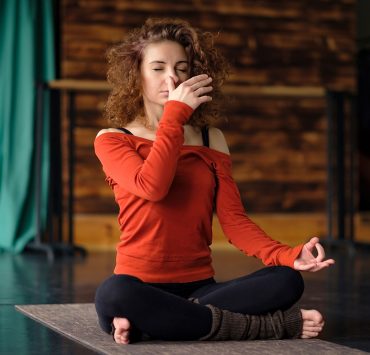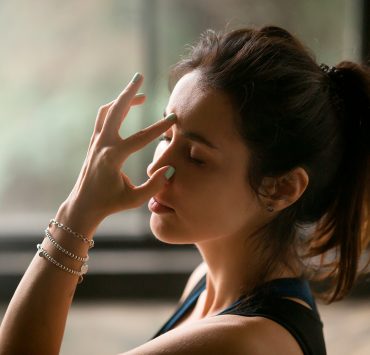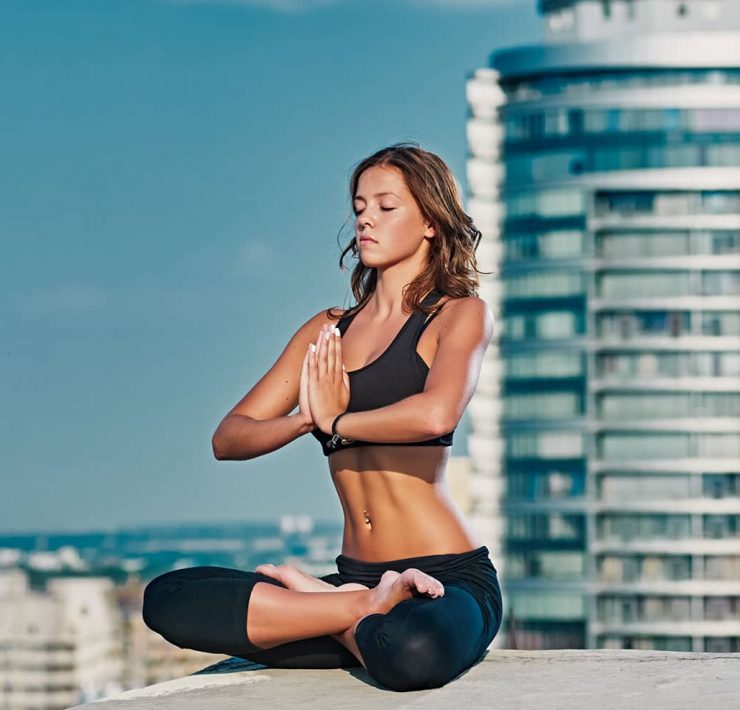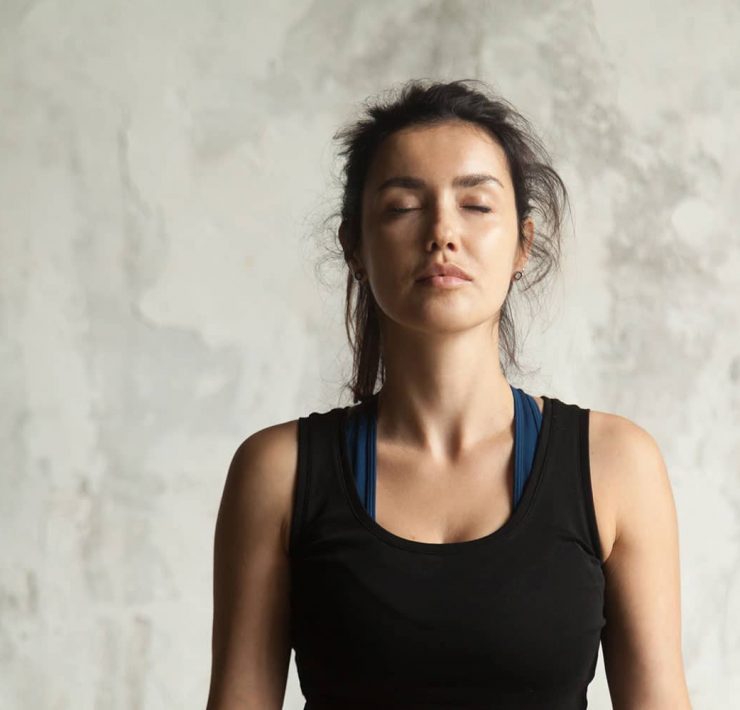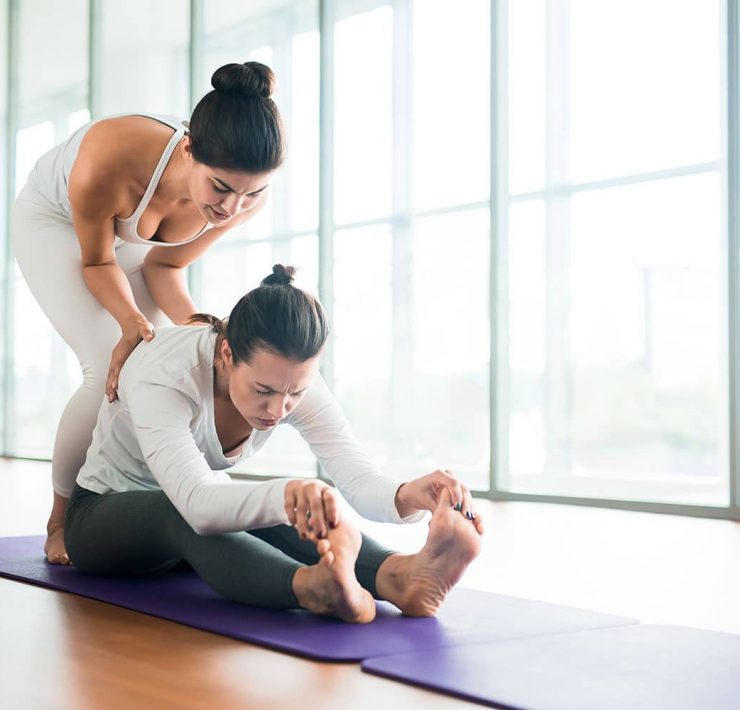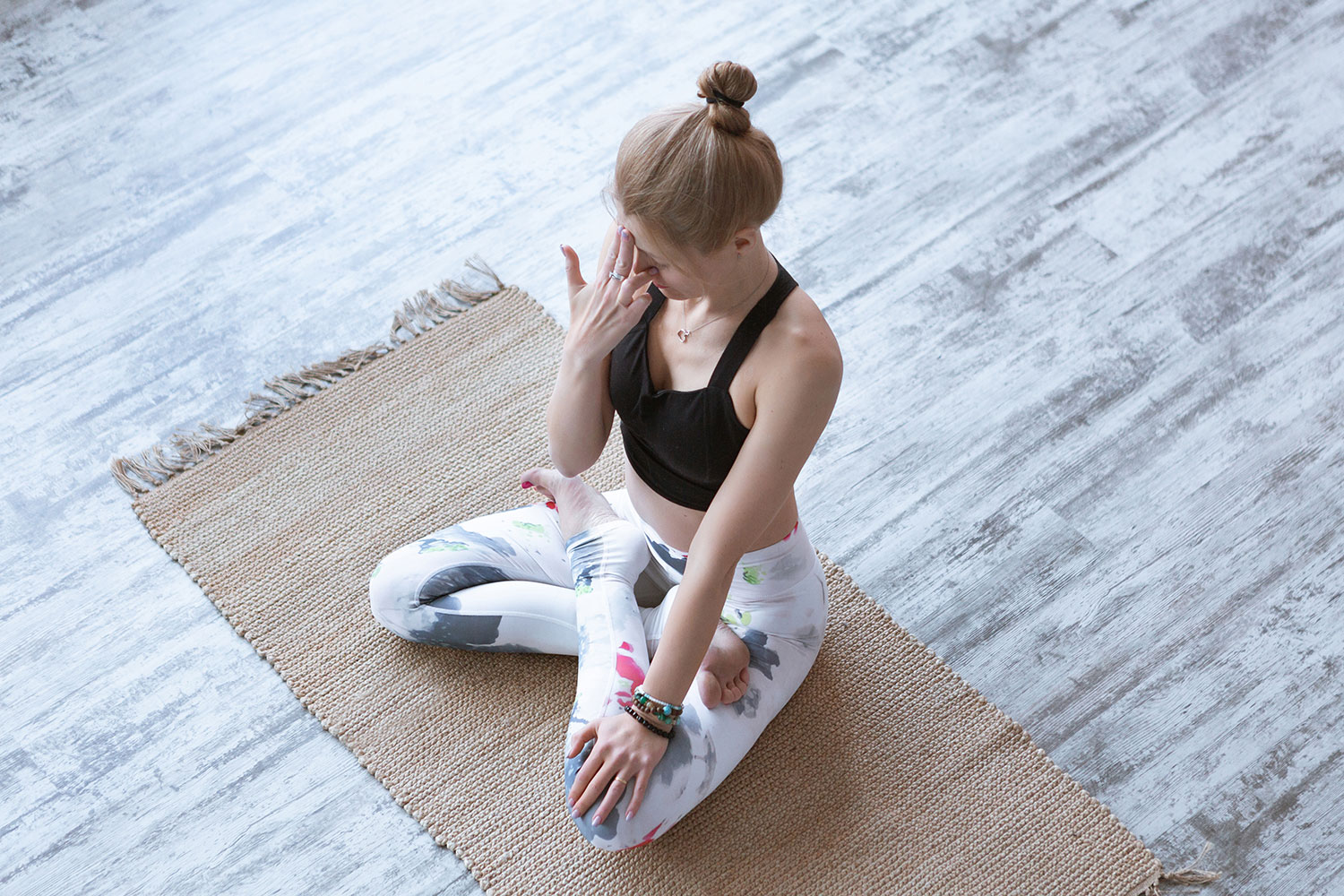
Catherine Perez is a celebrated yoga instructor in her home…
There are lots of elements that make up your yoga practice, but one of the most important parts is your breath and how you connect to it. Your breath and breathing are known as pranayama, which consists of two Sanskrit words: prana, which translates to “life force” or “vital energy”, and yama, which translates to “control” or “restraint”.
The practice of pranayama is about becoming aware of your breath as you inhale and exhale. The flow of breathing becomes conscious and willful as you concentrate on regulating breath through the inhale and hold on to the breath until you control it’s outward flow. Pranayama forces you to become conscious of your breath and in turn creates an awareness in your mind and body, establishing a full sense of being in alignment.
The process of pranayama is done in stages, with breath beginning slowly with an in and out breath through the nostrils or mouth, depending on what type of pranayama you’re practicing. Through pranayama you can direct the flow of energy throughout your body. The consciousness that comes with breathing helps to build a strong sense of “oneness” with the rest of the universe. The feeling of practicing pranayama with others in your yoga class can be empowering and highly spiritual.
History of Pranayama

Pranayama is referenced in numerous texts throughout history. Perhaps the earliest reference is in 700 BCE from the Brihadaranyaka Upanishad, one of the oldest scriptures of Hinduism:
He who breathes through your breath is your Self. Brihadaranyaka Upanishad 3.4.1
The concept of breath, body, and mind continues throughout history, with all being connected. As quoted in the early 1900s by Sri Ramana Maharshi, “Breath and mind arise from the same source”.
Today, the practice of pranayama is used in meditation and various yoga practices. Kundalini yoga places a huge emphasis on breath, using pranayama to manage the different states of relaxation and consciousness and move kundalini, or divine energy, through the chakras.
Types of Pranayama and Their Benefits

There are several different types of pranayama, each with their own unique benefits.
Nadi Shodhana
Also known as “alternate nostril breathing”, Nadi Shodhana is one of the more basic types of pranayama and is often used to create feelings of calm and peace. This pranayama is often used before meditating, helping to still the mind in preparation for mindfulness. Benefits of Nadi Shodhana pranayama:
- Relieves stress and anxiety
- Improves mental concentration
- Aligns and balances the two brain hemispheres
- Purifies and detoxes body energy
Ujjayi Breathing
Ujjayi pranayama is typically practiced in Ashtanga and Vinyasa yoga classes. Ujjayi breathing is used to slow down your practice with a focused breath. This pranayama is also used after a strenuous sequence of poses to bring awareness back to slower breathing and relaxation. Benefits of Ujjayi pranayama:
- Expands the lungs
- Promotes self awareness
- Builds up energy
- Increases oxygen flow through the blood
- Encourages a steady rhythm during yoga practice
Bhastrika
Also known as “bellows breath”, Bhastrika uses the abdominal muscles to create a series of fast inhalations and exhalations. This rapid breathing builds a heat in the body, helping to energize and detoxify. The fast compression of the chest while breathing helps to get the blood moving throughout the body and towards the head. Benefits of Bhastrika pranayama:
- Aligns and balances the nervous system
- Tones the digestive system and abdominal muscles
- Removes nose and chest blockage from colds and other respiratory problems
- Increases appetite
- Strengthens the lungs
Bhramari
Also known as “bee breath”, Bhramari uses a combination of breath and sound to calm and still the mind. Both the eyes and ears are closed during this pranayama, with the vibrations calming and soothing the nervous system. Benefits of Bhramari pranayama:
- Relieves anger, stress, and anxiety
- Alleviates pain from migraine headaches
- Promotes confidence and peace
- Stills the mind in preparation for mediation and yoga practice
- Helps with concentration and memory
- Can help reduce high blood pressure
Sama Vritti
Also known as “square breath”, the Sama Vritti pranayama is a balanced breath that is good for teaching us how to breathe correctly. The breath focuses the mind and rids it of distractions. Unlike other pranayama that require louder breath and some movement, Sama Vritti can be practiced anywhere as it requires only a quiet breath. Benefits of Sama Vritti pranayama:
- Relieves stress and anxiety
- Expands lung capacity
- Awakens and energizes both mind and body
Sitkari
The Sitkari pranayama is done with mouth breathing by pursing the lips slightly and allowing the tongue to push out a bit. The inhale of breath is done through the tongue, where the breath is then held before being exhaled through the nostrils. Benefits of Sitkari pranayama:
- Cools the body, including the nervous system and mind
- Manages stress, anger, and anxiety
- Treats insomnia and frequent night waking
- Treats hypertension
- Cures diseases of the liver and spleen
- Treats indigestion
Sitali
Similar to Sitkari, Sitali pranayama is also done through the mouth. Sitali helps to cool the mind, emotions, and body. This breathing technique is useful for women suffering from hot flashes or when you’re faced with an intensely emotional situation. Benefits of Sitali pranayama:
- Treats stress, anxiety, and depression
- Improves digestion
- Promotes healthy sleep patterns
- Relieves heat in hot weather
- Eases the mind
- Beneficial for heart problems
- Purifies and cleanses the blood
The Many Benefits of Pranayama

Pranayama and yoga have many benefits – even scientific research done on breathing and yoga can attest to the numerous beneficial health impacts of both. It’s important to note that there’s a big difference between just breathing and pranayama. We all breathe – without breath there is no life. But pranayama isn’t just the simple process of breathing, where you inhale and exhale.
Pranayama is about regulating your breathing. With some techniques the breath is slow and prolonged, with breath held, while with other techniques the breath is fast and forced. Where regular breathing involves only the physical side of your body, pranayama is an integration of the physical, the mental, and the spiritual. It’s this pranayama breathing that brings about the many benefits. As well as the benefits specific to each different type of pranayama, these are some of the many additional benefits and advantages of practicing pranayama daily:
- Improves self confidence and self awareness
- Improves function of the reproductive organs
- Cures headaches
- Treats asthma
- Keeps teeth and gums healthy
- Reduces mucus and phlegm
- Helps regulate weight by burning more fat
- Relieves constipation
- Treats gastric problems
- Treats neurological problems
- Gracefully manages the aging process
- Promotes spiritual happiness
Applying Pranayama To Your Daily Life

It’s easy to limit your practice of pranayama and yoga to the classroom, only engaging in your breath and poses when you’re in a room with your teacher at the front guiding you. While practicing with others is both energizing and peaceful, it’s important not to limit the practice of pranayama to this setting. Applying pranayama to your daily life is a great way to live in spiritual harmony with yourself and with those around you.
Learn from your pranayama practice and use this wisdom wherever you go and whatever you do. Consider how your practice is changing you and allowing you to be more loving and accepting of where you are in life today.
Manage Stress/Improve Energy
Use the awareness of pranayama to keep you calm whenever you’re feeling stressed or overwhelmed. It doesn’t matter what the situation is, if you’re feeling stress or anxiety, the feelings are real to you. Find a few moments to sit quietly and practice one of your favorite pranayama breathing techniques. Even if you only have 5 minutes, take advantage of this time to focus on your breath – feel the energy of your breathing flowing through you, relaxing you and slowing your thought and breath.
If you’re feeling slow and lethargic, taking a few minutes to practice pranayama can help you feel more energized so you can channel this energy into your day. Again, even if you only have a few minutes, taking this time to get into your breath can be revitalizing and positive. If you’re not in a position to sit in Sukhasana on the floor, take a walk instead and practice your breathing.
Use Your Breath to Reach Your Inner Spirit
Pranayama helps you connect with your inner spirit on all levels. The light is there within you – use your breath to bring it out. Be loving and kind not only to others, but also to yourself. Pranayama is a personal journey, a technique that should be applied throughout your life and not just on your yoga mat.
Pranayama Breathing Techniques

The techniques of pranayama focus on four main aspects of your breath:
- Puraka – the inhalation of breath
- Rechaka – the exhalation of breath
- Antara khumbaka – pausing after inhaling
- Bahya khumbaka – pausing after exhaling
The process of breathing in pranayama involves these four techniques. Each different type of pranayama uses these as the basis for breath.
When beginning the practice of pranayama, build up slowly with your breathing as you learn how to become aware of your breath. Begin by just sitting quietly, such as cross legged on the floor in easy pose (Sukhasana). Focus on your breath:
- Breathe in. Let your thoughts come and go as they please.
- Breathe out. Notice as you let go of these thoughts.
- Allow yourself permission to release these thoughts completely during your practice.
- Continue to breathe slowly in and out for a few minutes, emptying your mind and focusing on your breathing.
- Finish your breathing practice with one last breath and slowly return to a full awareness of life around you with an open and calm mind.
Once you’re comfortable with quiet breathing, you’re ready to move on to other pranayama breathing practices. Take time to explore different types of pranayama techniques. Once you have a few favorites, consider doing a pranayama sequence, such as the following:
- Open with a three-part breath for 3 to 5 minutes. Inhale into your belly, rib cage, and into your collarbones with a relaxed and smooth breath. Take this time to anchor yourself to the present and leave the past behind.
- One you have an even breath going, transition into the Ujjayi pranayama. Fill your lungs completely, contract your throat, and breathe through your nose. Listen to the ocean-like sound of your breathing for 2 to 3 minutes.
- Transition to Nadi Shodhana, breathing alternately through each nostril by closing the right with your thumb while inhaling through the left nostril, then closing the left with your forefinger and exhaling through the right – inhale through the right and exhale through the left. Continue with this breath for 5 minutes, taking the time to feel calm and let peace flow into your body.
After finishing the sequence, continue with your yoga practice. Alternately, this pranayama sequence is a calming way to end practice. If a pranayama practice was your only intent at this time, take a few minutes to sit in silence and “feel” your inner self.
Modify the pranayama sequence with your favorite pranayama techniques.
Tips for a Successful Pranayama Practice
- The ideal practice duration for pranayama is 5 to 10 minutes for beginners. Work your way towards 45 minutes to 1 hour of practice for optimum benefit.
- For the best results, practice pranayama on an empty stomach before breakfast or five hours after eating.
- If doing pranayama in the morning, drink 2 glasses of warm water before beginning or take a short walk to prepare the body for deep breathing.
- When possible, practice pranayama where there’s lots of fresh air.
- Before beginning pranayama, free your mind of worry and fear.
- To get the most out of your pranayama, practice regularly, at least once day.
- After your pranayama practice, take time to relax for 20 minutes before becoming active again either physically or mentally.
Precautions

There are some precautions to take when practicing pranayama, as these breathing techniques may not be safe for everyone. If you’re pregnant, avoid doing those pranayama where you have to exhale with force or where you’re holding your breath for an extended period of time.
If you have a chronic condition such as high blood pressure or heart disease, consult with your doctor before beginning your pranayama practice.
What's Your Reaction?
Catherine Perez is a celebrated yoga instructor in her home state of Connecticut, and she also happens to have a marvelous way with words. Her mindful writing technique is easy to digest and gives readers a unique opportunity to learn from a seasoned yogi.






